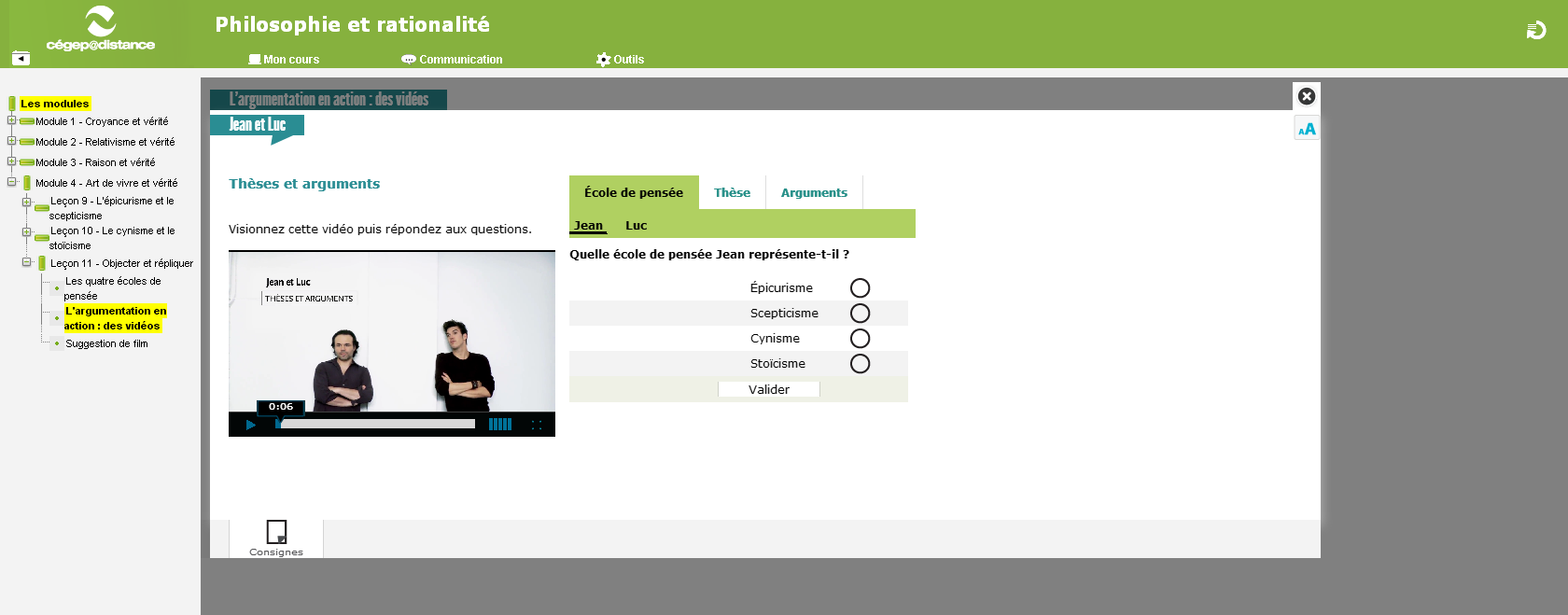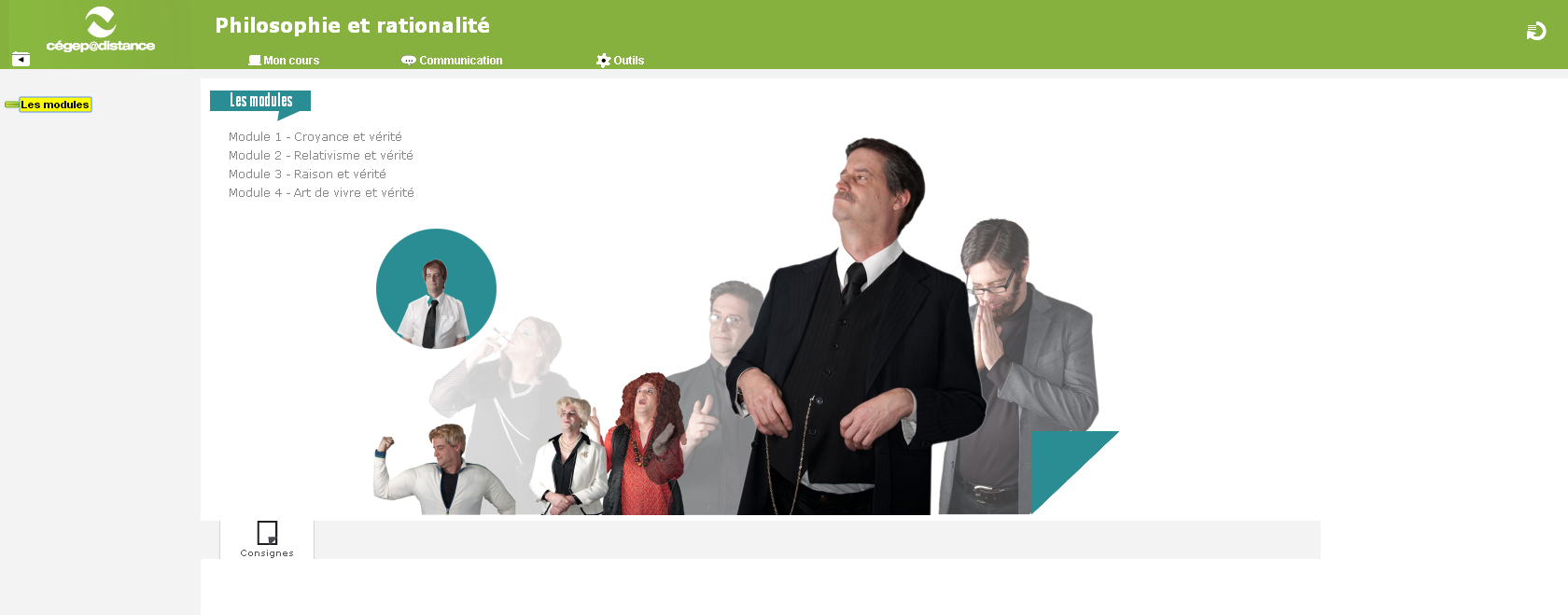A Mixed Media Approach for a Distance Education Course in Philosophy
The purpose of this story is to highlight some of the technological and pedagogical principles (videos, interactive exercises, forums, comic strips) that have underpinned the development of a distance education course in Philosophy. Let’s begin with a few characteristics of Cégep à distance’s model.
Distance learning allows students to acquire competencies outside of the traditional framework of a classroom, without the physical presence of a teacher. The teaching / learning situation is mostly asynchronous and individualized. The student must be autonomous, and the material produced is designed to be “self-contained” which is to say that all educational materials, whether printed or online, contain all the necessary elements required for the students to work independently. The student has six months to complete their course, and they may contact their tutor who acts as a resource person at any time.
I received a mandate to completely redesign the course entitled “Philosophie et rationalité.” As we know, philosophy is sometimes perceived by students as a difficult and opaque subject, or a discipline that has no practical application. The mandate was twofold:
- Redesign the course favouring a competency-based approach;
- Increase the motivation of students to take a course in philosophy by creating one that was meaningful, accessible, and current within the context of distance education.
The mixed media approach fairly quickly emerged as an avenue to satisfy these two requirements. As emphasized by my colleague Chantal Bénit, Production Manager at Cégep à distance, this approach uses multiple media to produce learning activities that maximize competency development. Conducted in close collaboration with a teacher of Philosophy from Collège Lionel-Groulx, Guy Ferland, who was working as a subject matter expert, we designed a new technopedagogical version of the course. It incorporated several media where forums, videos and interactive activities were at the forefront, all enlivened by amusing characters.
An up-to-date course with a competency-based approach
- The printed material is comprised of:
- A textbook and a workbook in which the subject matter expert comments on and completes the information from the textbook, while encouraging the student to write questions, arguments, objections, and, in short, do everything that contributes to the development of a persuasive essay.
- The course website includes:
- A variety of interactive exercises, such as multiple choice questions, sometimes introduced by amusing characters. The site also contains fill-in-the-blank and drag and drop exercises, brief scenarios with accompanying questions, and various association exercises.
- Videos showing two dialogues between actors who defend the point of view of one of the four schools of thought seen in the course. One of the first dialogues addresses a problem where an Epicurean and a Stoic each present their own ideas and arguments. Thereafter, they present their objections and rebuttals, which complete the elements of an argumentative discourse. The videos are interspersed with multiple-choice questions relating to these components. A Cynic and a Skeptic redo this dialogue with another problem. These videos represent an oral preview of the argumentative structure that students will be required to produce in writing for their final exam.

A course web page which provides access to videos
- Students also have access to two forums, one of which is a forum for exchange and open discussion of fallacies moderated by a tutor. Participating in the other forum is a mandatory part of an assignment. Here they must submit and analyze fallacies. In fact, every student posts a fallacy and, as part of their assignment, analyzes another filed by a different student.
- The study guide provides the information needed to start their distance education course as well as the specific course progression, a list of required materials, and information on assessments and available resources. A guide to strategies for review has been specifically designed for this course to help students methodically review their argumentative essays before handing them in.
- Internet addresses of relevant sites such as Sceptiques Quebec, various sites containing optical illusions, and a site with a film database are scattered throughout the student’s learning path. The film database proposes movies related to the topic of each lesson. For example, the film 12 Angry Men shows the use of fallacies in connection with the deliberation of a jury.
Meaningful and Accessible
Finally, to make the course material accessible, we decided to link the contribution of philosophers to the experiences of the students. For example, the principles of Socrates in Plato’s Crito become a reference for a current issue such as: “Should we obey an unjust law?” In the Allegory of the Cave, Plato raises the question of whether our senses are truly a source of knowledge or misleading.
Making philosophy accessible involves linking to the concerns that affect students, but with a touch of humour, which certainly includes the use of stereotypical caricatures. Among them is a bodybuilding enthusiast for whom only appearances matter, a fatalist for whom everything is predetermined, a know-it-all who never questions anything, and a hedonist who seeks pleasure at any price. All these characters throw in their preconceived notions, allowing the philosophers to chime in and restore rational thought.

The front page of the course modules with humorous characters
In Conclusion
This new course has been available since the end of 2012 and preliminary data based on a few hundred students has led us to believe that the success rate increased slightly from a previous version of the course that was only available in print. However, one must be very cautious about correlations between academic achievement and mixed media, as several other factors may explain these results. We remain optimistic, however, that a competency-based approach and the use of mixed media can help to increase student motivation and success.

